Related Research Articles

Rhymney is a town and a community in the county borough of Caerphilly, South Wales. It is within the historic boundaries of Monmouthshire. With the villages of Pontlottyn, Fochriw, Abertysswg, Deri and New Tredegar, Rhymney is designated as the 'Upper Rhymney Valley' by the local Unitary Authority, Caerphilly County Borough Council. As a community, Rhymney includes the town of Rhymney, Pontlottyn, Abertysswg, Butetown and Twyncarno.

Tredegar is a town and community situated on the banks of the Sirhowy River in the county borough of Blaenau Gwent, in the southeast of Wales. Within the historic boundaries of Monmouthshire, it became an early centre of the Industrial Revolution in Wales. The relevant wards collectively listed the town's population as 15,103 in the UK 2011 census.

Blackwood is a town, community and an electoral ward on the Sirhowy River in the South Wales Valleys administered as part of Caerphilly County Borough. It is located within the historic county of Monmouthshire.
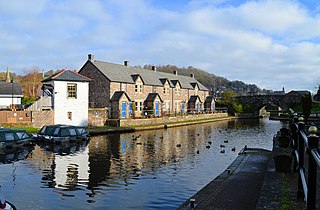
The Monmouthshire and Brecon Canal is a small network of canals in South Wales. For most of its currently (2018) navigable 35-mile (56 km) length it runs through the Brecon Beacons National Park, and its present rural character and tranquillity belies its original purpose as an industrial corridor for coal and iron, which were brought to the canal by a network of tramways and/or railroads, many of which were built and owned by the canal company.
Cwmfelinfach is a small village located in the Sirhowy valley of south-east Wales. It is part of the district of Caerphilly within the historic boundaries of Monmouthshire. It is located north of Wattsville, about 5 miles north of the nearest town Risca, and south of Blackwood. To the east the valley is bordered by the hills of Pen-y-Trwyn. To the west is Mynydd y Grug.
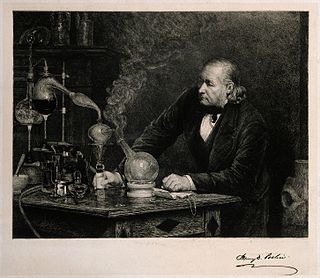
Henry Davis Pochin was a British industrial chemist. He invented a process that enabled white soap to be made and a means of using china clay to create better quality paper. He owned several china clay pits in Cornwall, and a mine at Tredegar in South Wales, and was briefly a Liberal Member of Parliament. His wife was Agnes Pochin who was a leading suffragist.

Bedwellty is a small village in Caerphilly County Borough in south Wales. The village stands on a ridge of high ground between the Rhymney and Sirhowy valleys. The village comprises St Sannan's parish church, public house and a few houses. The register of St Sannan's Church dates from 1624, which qualifies Bedwellty as an ancient parish. Historically the parish lay in the county of Monmouthshire, the hundred of Wentloog, Tredegar County Court District, the rural deanery of Bedwellty, the archdeaconry of Monmouth and the diocese of Llandaff. Several towns based on the iron industry expanded within the parish boundary, including from west to east, Rhymney, Tredegar and Ebbw Vale, which gradually gained administrative independence from Bedwellty between the 1870s and 1890s. A Bedwellty Local Government District was established for the rest of the parish in 1891, becoming an urban district in 1894.
The Sirhowy Valley is an industrialised valley in the eastern part of the Valleys region of Wales. It is named from the Sirhowy River which runs through it. Its upper reaches are occupied by the town of Tredegar within the county borough of Blaenau Gwent. The valley initially runs south-southeast between the ridges of Cefn Manmoel to the east and Mynydd Bedwellte to the west before turning to a more southerly direction. Its central section is one of the least populated of the Welsh coalfield valleys. The valley enters the county borough of Caerphilly, which contains the towns of Blackwood and Pontllanfraith. It then turns east and joins the valley of the Ebbw River, Ebbw Vale at Crosskeys.

Mining in Wales provided a significant source of income to the economy of Wales throughout the nineteenth century and early to mid twentieth century. It was key to the Industrial Revolution in Wales, and to the whole of Great Britain.

Cefn Coed Colliery Museum is a former coal mine, now operating as a museum. It is located at Crynant near Neath in the South Wales Valleys.
Oakdale is a large village in Caerphilly county borough, Wales, 9½ miles north of Caerphilly itself, within the historic boundaries of Monmouthshire. Situated in the Sirhowy valley, it is 1.5 miles (2.4 km) east of Blackwood, with which it forms a conurbation. At the 2001 census Oakdale had a population of 4,478.

Oakdale Colliery was a coal mine located in the Sirhowy Valley, one of the valleys of South Wales.
The Monmouthshire Railway and Canal Company was a canal and railway company that operated a canal and a network of railways in the Western Valley and Eastern Valley of Newport, Monmouthshire. It started as the Monmouthshire Canal Navigation and opened canals from Newport to Pontypool and to Crumlin from 1796. Numerous tramroads connected nearby pits and ironworks with the canal.

Bedwellty House is a Grade II-listed house and gardens in Tredegar, in the Sirhowy Valley in south-east Wales. It was built in the early 19th century on the site of an earlier building and subsequently enlarged into its present form by mid-century. The owners donated the house and its grounds to the public at the beginning of the 20th century. They were restored at the beginning of the 21st century. The grounds are included on the Cadw/ICOMOS Register of Parks and Gardens of Special Historic Interest in Wales, the only estate so listed in Blaenau Gwent.
The Sirhowy Tramroad was a plateway built to convey the products of ironworks at Tredegar to Newport, South Wales. It opened in 1805 between Tredegar and Nine Mile Point, a location west of Risca, from where the Monmouthshire Canal Company operated a tramroad to Newport. The Sirhowy Tramroad was operated at first by horse traction, but early locomotives were used, and a passenger service was operated.
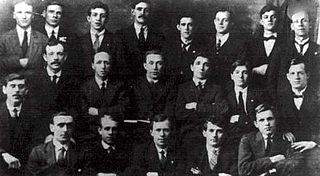
Walter Conway was the longstanding secretary of the Tredegar Medical Aid Society in South Wales. This society contributed the model which established the British National Health Service.
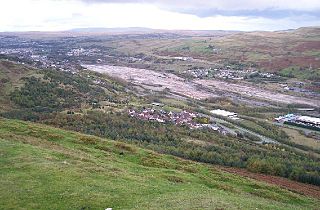
Ebbw Vale Steelworks was an integrated steel mill located in Ebbw Vale, South Wales. Developed from 1790, by the late 1930s it had become the largest steel mill in Europe. It was nationalised after World War II. As the steel industry changed to bulk handling, iron and steel making was ceased in the 1970s, and the site was redeveloped as a specialised tinplate works. It was closed by Corus in 2002, but is being redeveloped in a joint partnership between Blaenau Gwent Council and the Welsh Government.
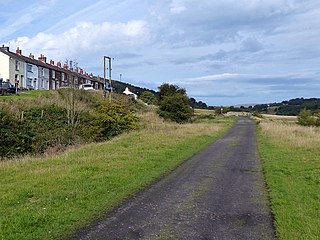
Bedwellty Pits Halt railway station was a station on the Sirhowy Railway. It was initially spelled Bedwelty, then known as Bedwellty Pits, and finally Bedwellty Pits Halt. It consisted of 2 wooden platforms to serve the workforce of the local colliery, which is 2 miles south of Tredegar in the Sirhowy Valley.

Sirhowy is a village in the Sirhowy Valley and the county of Blaenau Gwent.
References
- ↑ "A look at Old Tredegar in photographs" Volume 1 Philip Prosser Old Bakehouse Publications 1990
- ↑ B. Gardner's History of Tredegar and other information Archived 19 February 2005 at the Wayback Machine
- 1 2 3 4 5 "History". tredegar.co.uk. Retrieved 14 April 2011.
- ↑ Vaughan, Adrian (1985). Grub, water & relief Tales of the Great Western 1835-1892. London: John Murray. p. 3-4. ISBN 0-7195-4176-X.
- ↑ "Blaenau Gwent County Borough Council: Cefn Golau Cholera Cemetery". Archived from the original on 13 November 2010. Retrieved 5 November 2010.
- ↑ "Tredegar Iron and Coal Company". Durham National Coal Mining Museum. Retrieved 14 April 2011.
- ↑ Roberts, R. 2005 Southeast Wales Industrial Ironworks Landscapes, Year 1: the core ironworks areas Report for Cadw by GGAT p65
- ↑ "Welsh Coal Mines".
- ↑ "Pochin Colliery, Tredegar (33580)". Coflein. RCAHMW . Retrieved 30 September 2021.